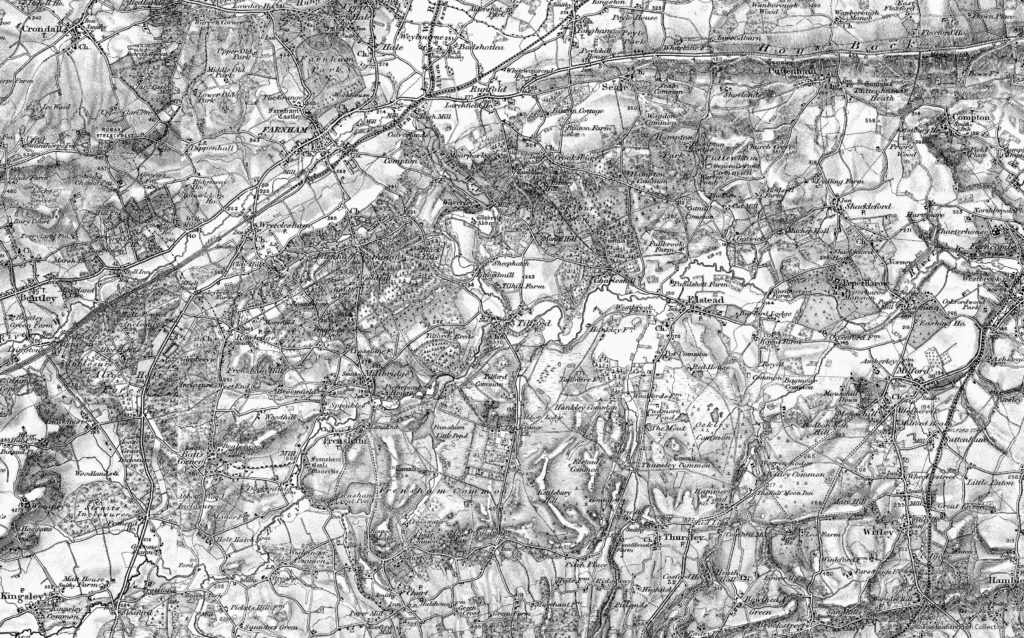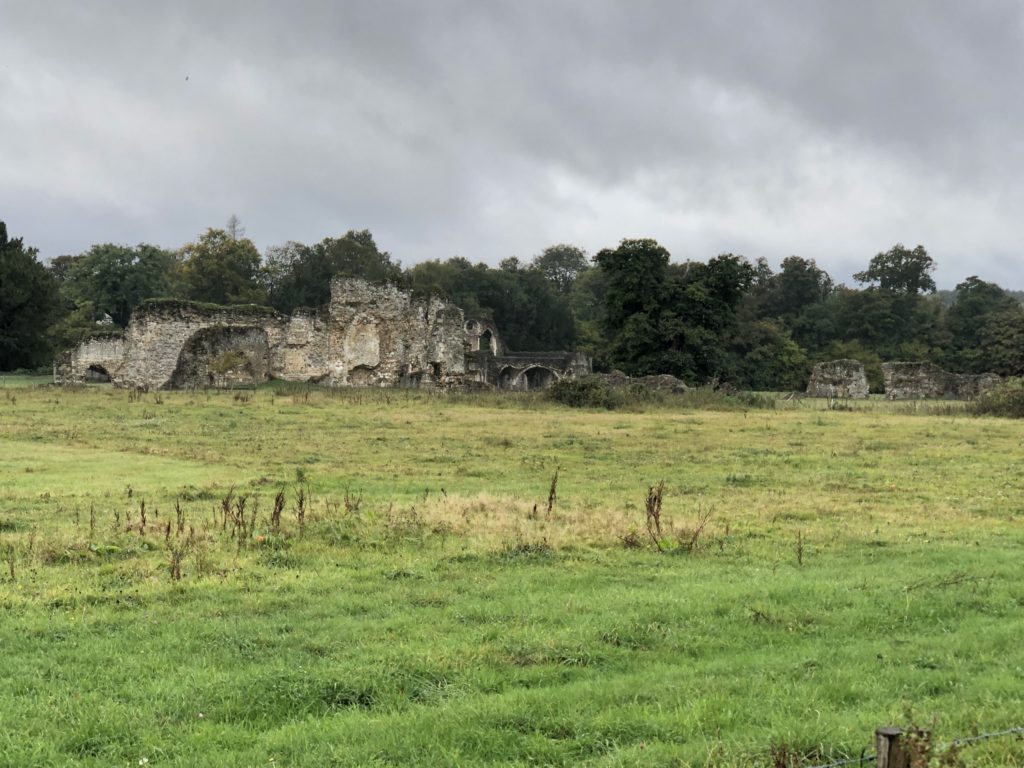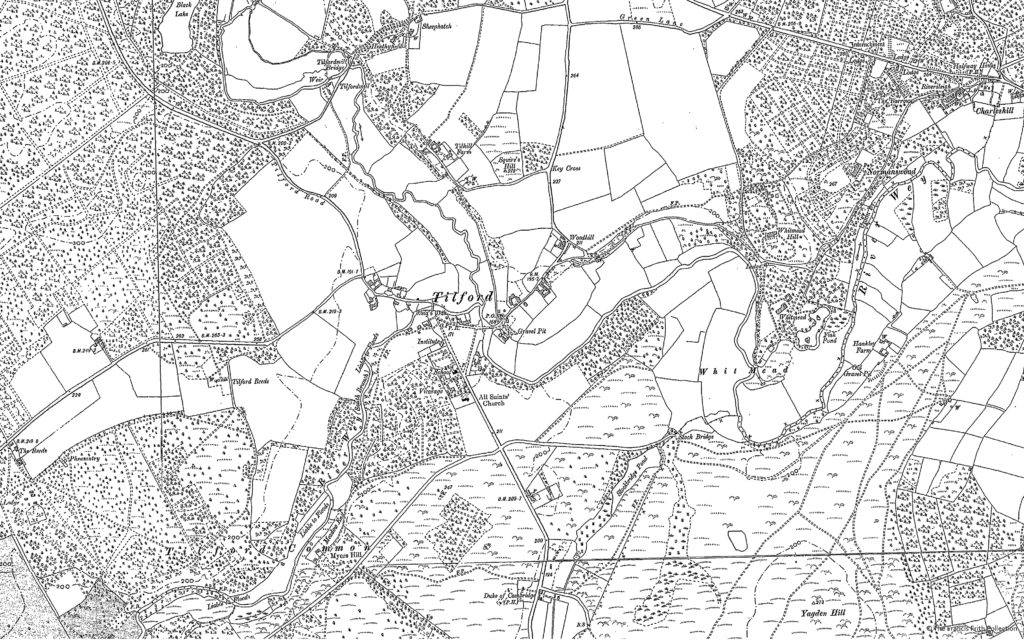The religious setting of Farnham and its surroundings
Asif Basit
As Hazrat Khalifatul Masih Vaa arrived back to the Markaz from his successful tour of Europe only a few days ago, we thought we would take a quick look at the history of the blessed place that is Islamabad

We see the suffix “ham” in names of many English towns and places – meaning an enclosure. A town enclosed in the English countryside of Surrey, surrounded by expanses of fern, got to be called Farnham. Among the finds of recent excavations are kilns dating back to the Paleolithic era – the early period of stone age. Further excavations have given archaeologists much material to link to all other ages that followed; from middle stone ages to latter, from the Bronze ages to the days of Iron and from the Romano-British occupation of the land to the centuries that followed.1
Reports of a 1924 excavation revealed sunken structures of a town dating back to the 6th century.2 Farnham is situated by the northern branch of River Wey, only three miles from Islamabad, Tilford. The first mention we find of Farnham in history is in the year 688 CE; about 50 years after the demise of the Holy Prophetsa of Islam. Cadwalla, the King of Wessex (685-688) granted this piece of land, called Farnham, for building a monastery and this was recorded in a charter in the following words:
“AD 688… Caedwalla, king of the (West) Saxons, to Cedde Cist and Criswa, grant, for the foundation of a minster, of land at Farnham, Surrey, including land at Binton and Churt, Surrey…”3
So, the first mention of Farnham and its surrounding land occurs when the King donated the town and its surrounding district to the Church and to the diocese of Winchester. By the 8th century, it was administered and run by the Bishop of Winchester. It was given the status of a manor, the lord being the Bishop of Winchester, and remained so for the thousand years that followed.4
Back then, the lord of a manor was entitled to collect taxes from a stretch of parishes surrounding his manor; this stretch of parishes was called a “hundred”. When William the Conqueror ordered a detailed survey of England to be carried out (1086) – the Domesday Survey – the hundred of Farnham consisted of around 16 parishes, including Waverley, Elstead and Tilford.5
Later, history has religion and politics intertwined just as the rest of England in those times. However, we know that the first spirit of religion was blown in the air of Farnham and its surroundings just a few years after the demise of the Holy Prophetsa of Islam, peace and blessings of Allah be upon him. The Holy Prophetsa had prophesied that the sun of Islam would rise from the west in the latter days when that the Messiah will counter Christianity in its hubs. Foundations for this big encounter being laid at Farnham coincide with the same time as the early foundations of Islamic eschatology.
Monastery at Waverley
Although a very small town, Farnham held an important place in the history of religion in England. It lay almost equidistant between London and Winchester. The Bishop of Winchester was classed among the highest officials of the state and would often be the Chancellor of England. Farnham naturally became a stopover for the bishop of Winchester on his way to London (and back) or on other journeys through the diocese. As bishop of Winchester was the lord of the manor of Farnham, it appears to be a favourite town for Henri of Blois (Bishop of Winchester from 1129 to 1171 and grandson of William the Conqueror) where he started building a castle – now known as the Farnham Castle – in 1138. The garrison and paraphernalia that emerged with the castle brought economic strength to Farnham.6
But before this castle was erected, another grand building had been established only a mile away in the valley of Waverley. This building was the Waverley Monastery that was built in by William Giffard, the then Bishop of Winchester and the Lord Chancellor of England (1100 to 1129) in 1128.7 That this man of great influence in the state affairs of England chose Farnham to house the monastery indicates the importance of the manor of Farnham in the religious history of England. Historians seem to agree that William Giffard’s decision of giving the 60 acres of land at Waverley to the monastery could be to uphold the charter of 688 that devoted Farnham for religious activity.8
The White Monks of Waverley
St Benedict of Nursia lived from c. 480 to c. 547 CE, dying only 30 years before the birth of the Holy Prophetsa of Islam. He is known as the Patron Saint of Europe for his great influence on the shaping of Western Christendom. He wrote his Rule – known as the Rule of St Benedict – in the year 516 CE which gained great following with major Catholic monastical orders taking it as their primary constitution. Monks of the St Benedictine order came to be commonly known as the Black Monks for the colour of their robes.

They were based at the Cluny Abbey in France, which was known as the base and headquarter of Western Monasticism. In the year 1098, some monks of the Cluny Abbey developed a grievance that the Rule of St Benedict was not being followed at Cluny in its strictest sense and, spearheaded by Abbot Robert of Molesme, left the monastery to establish one of their own – the aim being to establish the supremacy of St Benedict’s rule. They moved out and settled in Dijon in France, later to scatter and establish their monasteries in other parts of Europe.9
The first monastery to be built outside of France was to be in the valley of Waverley – just a mile away from Farnham. They called themselves the White Monks to be distinct from the Black Monks that they had broken away from. The formal name of their offshoot was the Order of Cistercians.10
Close ties with Henri of Blois had earned them this vast stretch of land as a gift from William Giffard, the Bishop of Winchester.11 Even close ties of Henri with William Giffard are evident from the fact that Henri succeeded William as Bishop of Winchester – the level of whose jurisdiction, authority and influence over England has been described above.
Gwen Ware so describes their arrival:
“Abbot John and his twelve monks came from Aumone, near Chartres. They probably landed at Pagham Harbour, then a well known port, and walked via Midhurst to Farnham where they arrived on November 24th, 1128; a silent little procession with none of the trappings associated with monks of the day, perhaps just carrying a plain wooden cross before them – forerunners of the great Cistercian invasion of England and filled with missionary fervour.”
Their success can be gauged by the growing numbers and the growing expanse of their land: in 20 years’ time, they had increased in number to 70 monks and 160 lay brothers, and the 60 acres of land had expanded to 571 acres. A beautiful abbey was built to house the religious activity and rituals of the monks as well as dormitories to house them.12

They now had four bridges and had a functional mill added to their territory. This expansion – bestowed as intermittent gifts by the Bishop of Winchester – had, by 1187, taken in its fold the area that we now know as Tilford. It extended from Elstead to the boundary of Farnham town.
Why did they need so much land? One major reason, according to historians, is the acquisition of grazing fields for the thousands of sheep that they kept. Well-wishers gifted the monks with sheep – adding up to thousands in number – which they kept on the high ground above the woods, where now runs the road called Sheephatch Lane.
Before being abolished in the time of King Henry VIII, the Waverley Abbey had seen four generations of daughter abbeys, one of them being the Forde Abbey in Somerset; its Abbot, named Baldwin, later rose to the highest rank in Anglican Church as archbishop of Canterbury.13
A short description of the architecture of Waverley Abbey will not be unfitting to close this section. DD Knowles described it as “the austerely beautiful architecture… Clean and lovely lines, pointed arches and a minimum of decoration with the fine proportions made up the picture”.14
Having stood in the beautiful valley of Waverley in the heart of Surrey for 400 years, the Waverley Abbey was dissolved in 1536 under King Henry VIII’s Dissolution of Monasteries act.15
In the words of Gwen Ware, “peace loving, industrious and philosophical in adversity with a background of practical charity; such was the community that lived and worked in the isolated valley”.
The Ahmadiyya Mission
Long gone were the days of the White monks at the Waverley Monastery and so were the days when religion was an integral part of England. Another 400 years had flown past the beautiful valley of Waverley, witnessing the abbey slowly crumble to ruins.
Time had travelled to 1984 and a small, yet flourishing community was looking for a piece of land to settle in. They discovered a land in Tilford that had once been part of the stretch of the Waverley monastery. They decided to purchase this desolate and abandoned plot of land.
This time, it wasn’t a Christian order going for this land. It wasn’t even a gift from a bishop or a king. It was, in fact, a Muslim sect that believed in the second coming of Jesus Christas in the body of Hazrat Mirza Ghulam Ahmadas of Qadian. It was the Ahmadiyya Muslims purchasing the piece of land with their very limited resources, generated merely by member subscription. A religious spirit was returning to this land after four centuries. The wind of spiritualism that had first reached this land around the time of the Holy Founder of Islam had once again returned in the time of the Messiah of the latter days.
With the land purchased and building structures refurbished, the Ahmadiyya community settled in and started using it for prayer, office work and residence of those who devoted their lives for the service of their faith. It was named Islamabad – the home of Islam.
The community was rapidly spreading across the world and followers would assemble in the vast grounds of Islamabad in Tilford. Their zealous slogans of Allaho Akbar (God is Greatest!) echoed across the hills of Surrey announcing the return of religious fervour to the land. Their peaceful propagation of the message of Islam continued from Islamabad in Tilford but turning the eight-decade old wooden structures into a modern settlement took many turns before the local authorities could be satisfied with giving the green signal.
So flew past another 35 years. The Ahmadiyya community was, in 2016, finally given permission by the Waverley Council to build their central headquarters on this piece of land in Tilford. The work lasted three years before there emerged a beautiful colony where settled families of those who have vowed to devote themselves entirely for the service of their faith; to propagate the message of the Messiah of the age. A beautiful mosque where God Almighty is worshipped five times a day is the hallmark of the architecture of the colony.
Describing the architecture, the echo of Dr Knowle’s words can be heard:
“The austerely beautiful architecture … Clean and lovely lines … and a minimum of decoration with the fine proportions [make] up the picture”.
To describe the people living here and associated to it, the words of Gwen Ware echo:
“Peace loving, industrious and philosophical in adversity with a background of practical charity; such [is] the community that [lives] and [works]” in Islamabad.
The head of this worldwide community and Caliph of the Messiah of the Age, Hazrat Mirza Masroor Ahmadaa, resides in this colony. From dawn to dusk and dusk to dawn, he is engaged in calling the world to peace. His mission is global, and he runs it from Tilford near Farnham – the land with deep roots of religion in its heart and soul. From here, he strives to call the world to its Creator.
Islamabad is home to a peace loving Muslim community. It sits on Sheephatch Lane. Only that the sheep that it got its name from are no longer there. However, Hazrat Mirza Masroor Ahmadaa believes that the lost sheep of not only the Israelites and not only of the Waverley monks but of all nations will one day assemble at Sheephatch Lane. All faiths will one day be united at Islamabad.
Endnotes:
1. K P Oakley, A Survey of the Prehistory of the Farnham District, Surrey Archeological Collections, 1939
2. Ibid
3. P H Sawyers, Anglo-Saxon Charters: An Annotated List and Bibliography, Offices of the Royal Historical Society, London, 1968
4. M W Thompson, Farnham Castle, Ministry of Works, London, 1961
5. E Robo, Mediaeval Franham: Everyday Life in an Episcopal Manor, EW Langham, 1935
6. H E Malden, The Victoria History of the County History of Surrey, Vol 4, 1912
7. H Brakspear, Waverley Abbey, The Surrey Archaeological Society, Guildford, 1905
8. G Ware, The White Monks of Waverley, The Farnham and District Museum Society, Farnham, 1976
9. H Brakspear, Waverley Abbey
10. Ibid
11. Ware, White Monks
12. Brakspeare, Waverley Abbey
13. Ware, White Monks
14. D D Knowles, The Religious Orders in England, Cambridge University Press, 1950
15. C Kerry, A History of Waverley Abbey, Andrews and Son, Guildford, 1873


I would love to know why part of the site was referred to as “the Holy Land” many years before any Khalifa had seen it, let alone stepped on its holy soil.